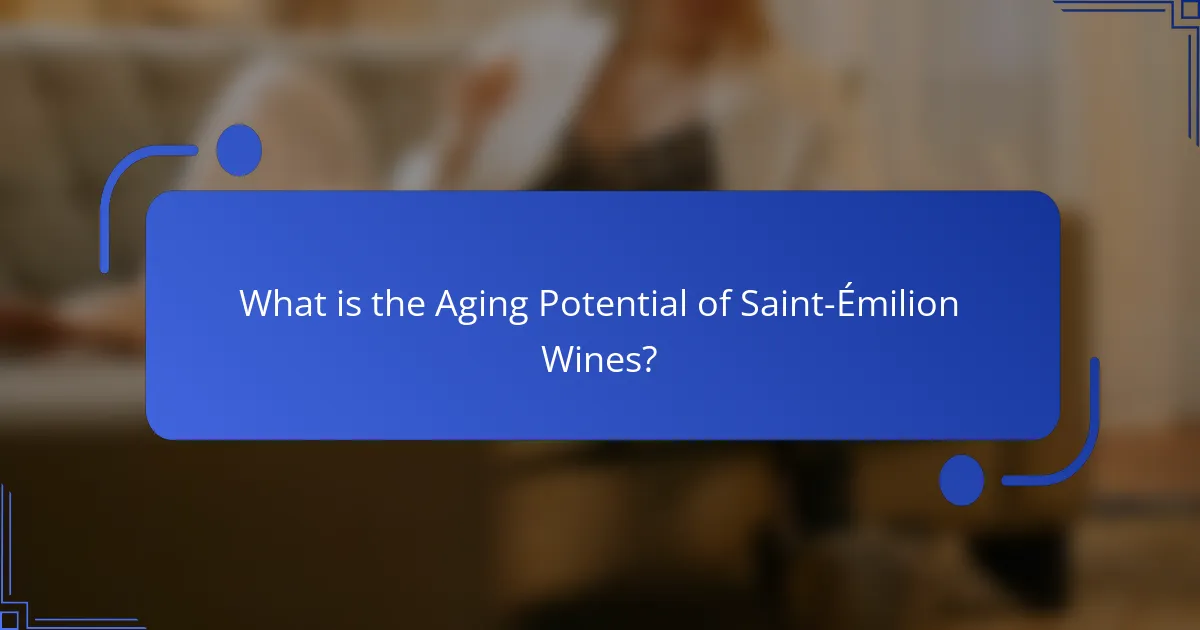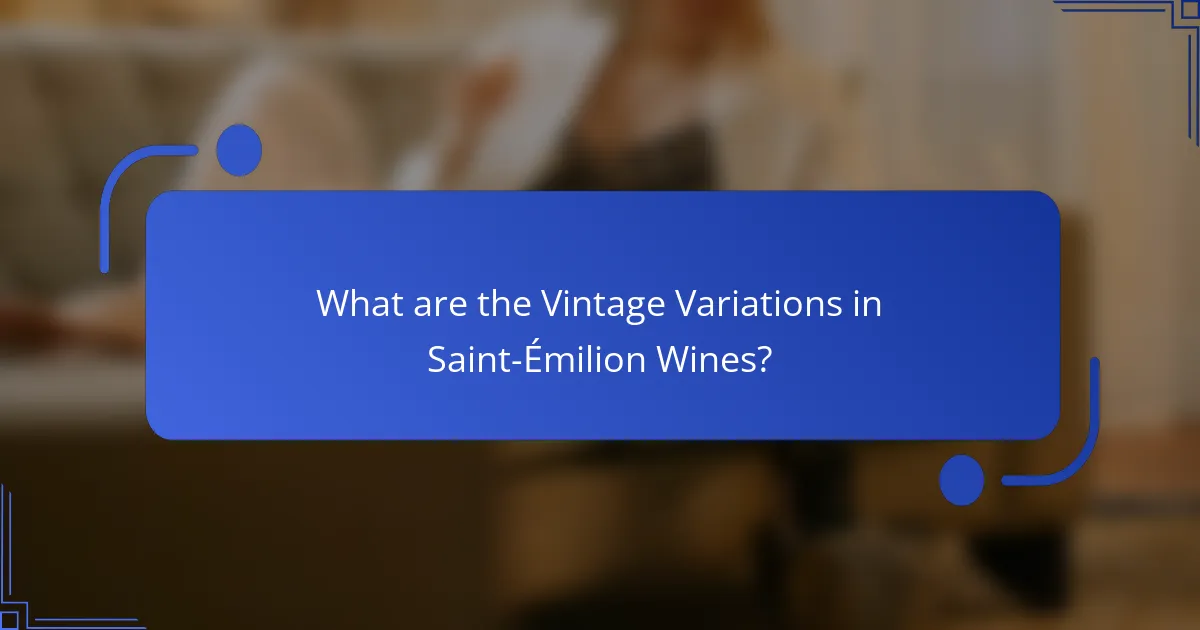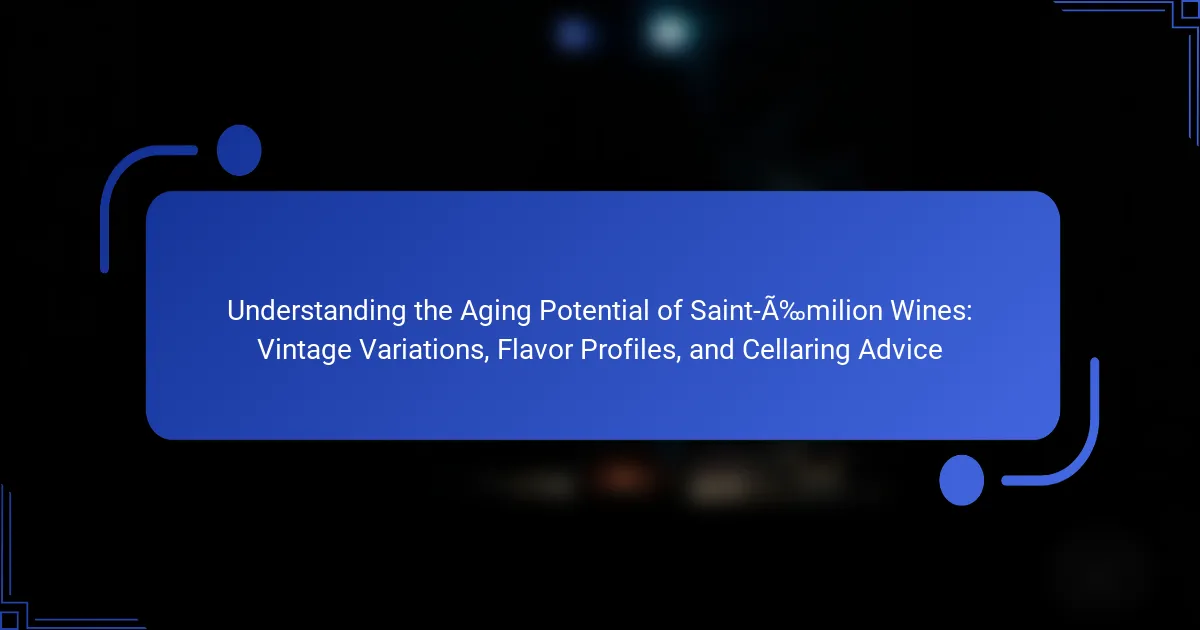
What is the Aging Potential of Saint-Émilion Wines?
The aging potential of Saint-Émilion wines is generally high. These wines are primarily made from Merlot and Cabernet Franc grapes. They often possess robust tannins and balanced acidity. These characteristics contribute to their ability to age well over time. Many Saint-Émilion wines can improve for 10 to 30 years. Some prestigious vintages can even age beyond 30 years. Historical records show that top producers like Château Ausone and Château Cheval Blanc have exceptional longevity. The complexity and depth of flavors evolve with age, enhancing the overall wine experience.
How does the aging process influence the characteristics of Saint-Émilion wines?
The aging process significantly influences the characteristics of Saint-Émilion wines. As these wines mature, their tannins soften and integrate, leading to a smoother mouthfeel. Aging also enhances the complexity of flavors. Primary fruit notes evolve into secondary aromas like leather, tobacco, and earthy undertones. The wine’s color may deepen, shifting from vibrant purple to garnet. Additionally, the aging process allows for oxidation, which can improve the wine’s overall balance. Research indicates that wines aged for 10 to 20 years often show more nuanced profiles compared to younger vintages. Thus, the aging process is crucial for developing the signature characteristics of Saint-Émilion wines.
What chemical changes occur during the aging of these wines?
During the aging of Saint-Émilion wines, several chemical changes occur. These changes include the oxidation of phenolic compounds, which enhances color stability and complexity. Tannins polymerize, leading to a smoother mouthfeel. Acidity decreases, resulting in a softer taste profile. Volatile compounds evolve, contributing to the development of secondary aromas. Esterification occurs, creating fruity and floral notes. The balance of sugar and acid shifts, affecting sweetness perception. These chemical transformations are essential for the wine’s maturation and flavor development.
How does aging affect the aroma and flavor profile of Saint-Émilion wines?
Aging significantly enhances the aroma and flavor profile of Saint-Émilion wines. As these wines age, they develop complex aromas such as dried fruits, leather, and earthy notes. The tannins soften over time, leading to a smoother mouthfeel. Additionally, aging allows for the integration of oak flavors, contributing vanilla and spice characteristics. The fruit flavors evolve, often shifting from fresh to more mature, jammy profiles. This transformation typically occurs over a span of several years, depending on the vintage and storage conditions. Research indicates that optimal aging can enhance sensory qualities, making the wine more enjoyable.
What factors contribute to the aging potential of Saint-Émilion wines?
The aging potential of Saint-Émilion wines is influenced by several key factors. The grape variety used plays a significant role; Merlot and Cabernet Franc are predominant, known for their structure and tannins. Tannins provide a backbone for aging. The level of acidity in the wine also affects its longevity. Higher acidity helps preserve freshness over time.
Soil composition in Saint-Émilion, particularly clay and limestone, contributes to the complexity and aging ability. The climate conditions during the growing season impact fruit ripeness and balance. Winemaking techniques, such as oak aging, add depth and enhance aging potential.
Finally, the vintage itself can greatly influence aging potential, as weather variations affect grape quality. Collectively, these factors determine how well a Saint-Émilion wine can evolve and improve over time.
How do grape varieties impact aging potential?
Grape varieties significantly influence the aging potential of wines. Different varieties possess unique chemical compositions. These compositions affect acidity, tannins, and phenolic compounds. High tannin levels often correlate with better aging capacity. For example, Cabernet Sauvignon typically ages well due to its robust tannins. In contrast, lighter varieties like Pinot Noir may not age as long. Additionally, the acidity in grape varieties can enhance longevity. Wines with higher acidity, such as Riesling, often age gracefully. Therefore, the choice of grape variety is crucial for determining a wine’s aging potential.
What role does vineyard location play in the aging process?
Vineyard location significantly influences the aging process of wines. The climate, soil composition, and topography of a vineyard affect grape quality. Warmer climates can lead to riper grapes, contributing to higher sugar levels and potential alcohol content. Cooler regions often produce grapes with higher acidity, which can enhance aging potential. Soil types, such as limestone or clay, provide unique mineral characteristics that can impact flavor complexity over time. The elevation of a vineyard can also affect temperature variations, influencing grape ripening and phenolic development. Studies have shown that wines from well-situated vineyards tend to age more gracefully, developing desirable characteristics over time. Thus, vineyard location plays a critical role in determining the aging potential and overall quality of wines.

What are the Vintage Variations in Saint-Émilion Wines?
Vintage variations in Saint-Émilion wines are significant and influenced by climatic conditions each year. Each vintage reflects the weather patterns, including temperature and rainfall, impacting grape ripening. For example, warmer years often yield ripe, fruit-forward wines. Conversely, cooler years can produce wines with higher acidity and more structure.
The 2015 vintage is noted for its ripe fruit and softness. In contrast, the 2016 vintage is recognized for its balance and aging potential. Historical data shows that vintages like 2005 and 2010 are also highly regarded for their complexity and longevity.
These variations lead to differences in flavor profiles and aging potential. Wine critics often rate these vintages based on their quality and characteristics. Thus, understanding vintage variations helps consumers select wines that match their preferences.
How do different vintages affect the quality and aging potential?
Different vintages significantly affect the quality and aging potential of wines. The vintage year indicates the specific growing conditions experienced by the grapes. Factors such as climate, rainfall, and temperature influence the grape’s ripeness and health. For example, a warm vintage may produce fruitier wines with higher alcohol content. Conversely, cooler years can lead to wines with more acidity and structure.
Saint-Émilion wines from exceptional vintages, like 2010 or 2015, often demonstrate greater complexity and longevity. These years typically feature optimal weather conditions that enhance grape quality. Research shows that wines from these vintages can age gracefully for several decades.
In contrast, less favorable vintages may yield wines that are less structured and more prone to oxidation. Thus, the choice of vintage is crucial for wine collectors and enthusiasts focusing on aging potential.
What climatic conditions influence vintage variations in Saint-Émilion?
Climatic conditions significantly influence vintage variations in Saint-Émilion. Temperature plays a crucial role, as warmer years typically lead to riper grapes. This can enhance the wine’s fruit flavors and overall complexity. Rainfall patterns also affect the region. Excessive rain can dilute grape concentration, while drought can stress vines, impacting flavor intensity. The timing of these climatic events is critical. For instance, late-season rains can lead to fungal diseases, negatively affecting harvest quality. Historical data shows that notable vintages often correlate with specific weather patterns. For example, the exceptional 2010 vintage was marked by a warm, dry summer.
How can one identify a good vintage for aging?
A good vintage for aging can be identified by evaluating specific climatic conditions during the growing season. Key factors include a warm and dry summer, which promotes optimal grape ripeness. Additionally, late-season rainfall can enhance flavor concentration if it occurs at the right time. Historical data shows that vintages such as 2005 and 2010 in Saint-Émilion produced wines known for their aging potential.
Wines from these years exhibit balanced acidity and tannin structure, essential for long-term aging. Furthermore, consulting wine ratings and expert reviews can provide insights into a vintage’s quality. Notable wine critics often highlight exceptional vintages that are suitable for aging based on their assessments.
What are the key characteristics of notable vintages?
Notable vintages are characterized by optimal weather conditions, which influence grape quality. Ideal temperatures and rainfall during the growing season enhance ripeness and flavor concentration. Consistent sunshine allows grapes to develop complex aromas. Soil health and vineyard management also play crucial roles in vintage quality. Historical data shows that vintages like 2010 and 2015 in Saint-Émilion produced exceptional wines due to these factors. The 2010 vintage is noted for its balance and structure, while the 2015 vintage is recognized for its richness and depth. These characteristics contribute to the aging potential of the wines, making them sought after by collectors.
Which years are considered exceptional for Saint-Émilion wines?
Exceptional years for Saint-Émilion wines include 2005, 2009, 2010, 2015, and 2016. These vintages are noted for their outstanding quality and aging potential. The 2005 vintage is praised for its rich fruit and structure. The 2009 and 2010 years produced wines with exceptional balance and depth. The 2015 vintage is recognized for its elegance and complexity. Lastly, the 2016 vintage is celebrated for its concentration and freshness. Each of these years has been highlighted by wine critics for their remarkable characteristics and longevity.
How do aging expectations differ among various vintages?
Aging expectations differ significantly among various vintages of Saint-Émilion wines. Each vintage reflects unique climatic conditions that impact grape ripeness and acidity. For instance, warmer years often produce wines with higher alcohol content and softer tannins, leading to earlier drinkability. Cooler vintages may yield wines with higher acidity and tannin structure, enhancing their aging potential. Historical data shows that vintages like 2005 and 2010 are renowned for their longevity, often aging well beyond 20 years. In contrast, more recent vintages, such as 2015, are generally more approachable at a younger age. Therefore, understanding the specific characteristics of each vintage is crucial for predicting aging expectations.

What Flavor Profiles Can Be Expected from Aged Saint-Émilion Wines?
Aged Saint-Émilion wines typically exhibit complex flavor profiles. These wines often showcase rich dark fruit flavors, such as blackberry and plum. Over time, secondary notes of leather and tobacco develop. Aged examples may also reveal earthy undertones, including truffle and forest floor. Additionally, hints of spice, like clove and cinnamon, can emerge. The tannins soften with age, contributing to a smoother mouthfeel. Acidity remains balanced, enhancing the wine’s longevity and character. These characteristics are influenced by the region’s terroir and the specific grape varieties used, primarily Merlot and Cabernet Franc.
How do flavors evolve as Saint-Émilion wines age?
As Saint-Émilion wines age, their flavors evolve significantly. Initially, these wines present vibrant fruit notes, such as cherry and plum. Over time, these fruit flavors become more nuanced, transitioning to dried fruits and fig. The tannins in younger wines are firm and pronounced. As the wine ages, these tannins soften and integrate, creating a smoother mouthfeel.
Aging also introduces secondary flavors like leather, tobacco, and earthy notes. These complexities arise from the wine’s interaction with oak barrels and the oxidation process. The evolution of flavors can take several years, with optimal aging often occurring between 5 to 15 years, depending on the vintage and specific wine.
Research indicates that the aging process enhances aromatic compounds, resulting in a richer bouquet. This transformation is a hallmark of high-quality Saint-Émilion wines, making them sought after by collectors and enthusiasts.
What primary flavors are present in young versus aged wines?
Young wines primarily exhibit fresh fruit flavors such as berries, citrus, and stone fruits. These flavors are vibrant and pronounced. In contrast, aged wines develop more complex flavors including dried fruits, nuts, leather, and earthy notes. The aging process allows these flavors to mature and integrate. Young wines often have higher acidity and tannins, contributing to their crispness. Aged wines typically show a smoother mouthfeel and softer tannins. This transformation occurs due to chemical reactions during aging, such as oxidation and polymerization. The flavors evolve over time, reflecting the wine’s journey from youth to maturity.
How do tannins and acidity change over time in these wines?
Tannins and acidity in Saint-Émilion wines evolve significantly over time. As these wines age, tannins typically soften, leading to a smoother mouthfeel. This softening occurs due to the polymerization of tannins, which reduces their astringency. Acidity, on the other hand, tends to remain stable or gradually decrease. This stability contributes to the wine’s overall balance. The aging process allows for complex flavor development, enhancing the wine’s profile. Research indicates that wines with higher acidity can age longer, maintaining freshness. In contrast, wines with lower acidity may lose vibrancy more quickly. Therefore, understanding these changes is crucial for optimal cellaring and enjoyment.
What are the distinctive tasting notes of well-aged Saint-Émilion wines?
Well-aged Saint-Émilion wines exhibit distinctive tasting notes of dark fruit, such as black cherry and plum. They often showcase earthy undertones, including leather and truffle. Additionally, well-aged examples may reveal hints of cocoa and tobacco. The aging process enhances complexity, introducing flavors of cedar and spice. Tannins soften over time, contributing to a smoother mouthfeel. These wines typically present a balanced acidity, which helps maintain freshness. The unique terroir of Saint-Émilion influences these characteristics, with its clay and limestone soils playing a significant role. Overall, the interplay of fruit and earthy notes defines the profile of well-aged Saint-Émilion wines.
What secondary and tertiary flavors develop with age?
Secondary flavors that develop with age in Saint-Émilion wines include leather, tobacco, and earthy notes. Tertiary flavors often consist of dried fruits, nuts, and spices. These flavors emerge as the wine undergoes chemical changes during aging. The aging process allows the tannins to soften and the wine to gain complexity. For instance, leather and tobacco notes typically appear after several years of maturation. Dried fruits and nuts may develop after a decade or more. This evolution in flavor is influenced by factors such as grape variety and storage conditions. The combination of these flavors enhances the overall tasting experience of aged Saint-Émilion wines.
How can one describe the mouthfeel of aged Saint-Émilion wines?
Aged Saint-Émilion wines typically exhibit a smooth and velvety mouthfeel. This characteristic arises from the integration of tannins over time. The aging process softens the tannins, making them less astringent. Consequently, the texture becomes more rounded and luxurious. Aged wines also present a fuller body, contributing to a rich sensory experience. The mouthfeel can be described as both silky and harmonious. Additionally, the wine’s acidity balances the texture, enhancing the overall drinking experience. This combination of factors results in a complex mouthfeel that is highly regarded by connoisseurs.
How should one properly cellar Saint-Émilion wines for optimal aging?
To properly cellar Saint-Émilion wines for optimal aging, maintain a consistent temperature between 50-55°F (10-13°C). This temperature range promotes slow aging and preserves the wine’s integrity. Additionally, store the bottles horizontally to keep the cork moist. A moist cork prevents air from entering the bottle. The ideal humidity level is around 70%, which helps prevent cork drying. Ensure the cellar is dark, as light exposure can degrade the wine. Finally, minimize vibrations to avoid disturbing the sediment. These conditions align with winemaking recommendations for enhancing the aging potential of Saint-Émilion wines.
What are the ideal storage conditions for aging these wines?
The ideal storage conditions for aging Saint-Émilion wines include a temperature range of 50-55°F (10-13°C). This temperature promotes slow and steady maturation. Humidity levels should be around 70%, preventing cork drying and oxidation. Wines should be stored horizontally to keep the cork moist. Light exposure must be minimized, as UV rays can degrade wine quality. Vibration should be avoided, as it can disturb sediment and affect aging. Finally, wines should be stored in a dark, quiet environment to maintain optimal conditions for aging.
How long can one expect to cellar different vintages of Saint-Émilion wines?
Saint-Émilion wines can generally be cellared for 5 to 30 years depending on the vintage. Young vintages, such as those from less renowned years, are best enjoyed within 5 to 10 years. Mid-range vintages, recognized for their quality, can be cellared for 10 to 15 years. Exceptional vintages, such as those from classified growths, often improve with age and can be cellared for 20 to 30 years or more. The aging potential is influenced by factors like the grape variety, vineyard practices, and vintage conditions. Notably, the 2015 and 2016 vintages are widely regarded as excellent and can age gracefully for several decades.
What practical tips are there for enjoying aged Saint-Émilion wines?
To enjoy aged Saint-Émilion wines, first ensure proper storage conditions. Ideal temperatures range from 50°F to 55°F (10°C to 13°C). Maintain humidity levels between 50% and 70% to prevent cork damage. Use a decanter to aerate the wine before serving. This enhances its complex flavors and aromas. Serve at the right temperature, typically between 60°F to 65°F (15°C to 18°C). Pair aged Saint-Émilion wines with rich foods like lamb or beef. This complements the wine’s tannins and acidity. Finally, enjoy the experience slowly to appreciate the wine’s depth and character. These practices enhance the overall tasting experience of aged Saint-Émilion wines.
The main entity of the article is the aging potential of Saint-Émilion wines, which are primarily made from Merlot and Cabernet Franc grapes. The article provides a comprehensive overview of the factors influencing aging potential, including grape variety, vineyard location, and climatic conditions. It details the chemical changes and flavor profile evolution that occur during aging, highlighting the significance of vintage variations and optimal cellaring practices. Additionally, it discusses the expected aging duration for different vintages and offers practical tips for enjoying these wines at their best.
